A Butt Log Identification Puzzle
Are these logs American Beechnut, Red Elm, Butternut, or what? In this long and detailed thread, sawmillers discuss the characteristics that could be clues. November 16, 2011
Question
I picked up these logs from my log guy who said they were American beechnut. I'm very familiar with beech, but never heard of the other. The leaves looked very similar to that of elm. They did not have the shine that beech leaves do. Also the bark on these logs is rough and somewhat deep unlike the smooth bark of beech. Can you help?
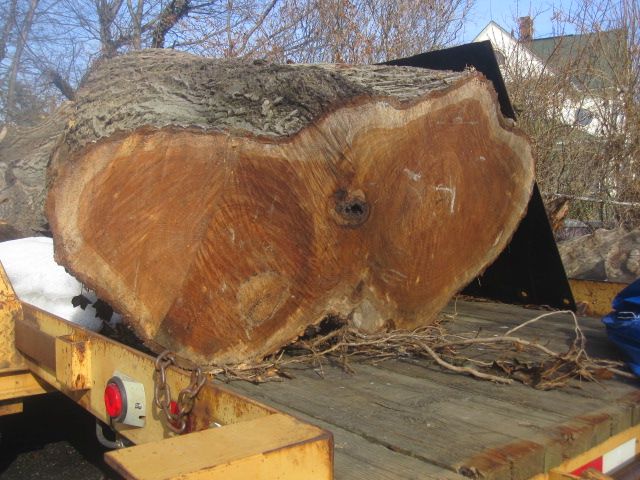
Click here for the higher quality, full size image
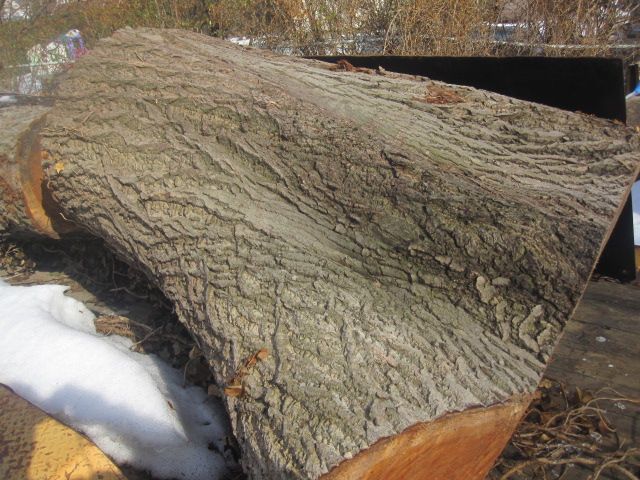
Click here for the higher quality, full size image
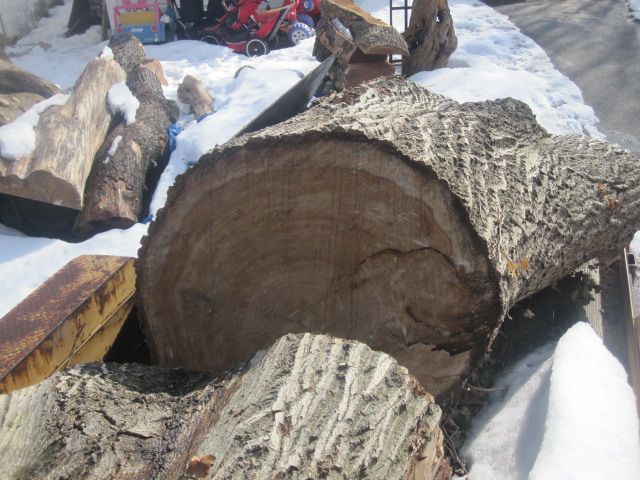
Click here for the higher quality, full size image
Forum Responses
(Sawing and Drying Forum)
From contributor A:
Looks like what I call red elm. It saws okay and is good for making bows.
From Professor Gene Wengert, forum technical advisor:
American beech is sometimes called beechnut.
From the original questioner:
Thanks for the quick response. I am anticipating a lot of figure in these slabs and just wanted to be accurate on the species. So what is the difference between beechnut and regular beech? I was also told it looked to be English elm.
From contributor R:
A clear picture of the end grain would help. I'm seeing characteristics of butternut. I have never seen a beech with bark or heartwood like that. Not only does the bark and heartwood look like butternut, but bark included crotches on butternut are very common, even on wide spread crotches like yours.
From contributor W:
If it is elm, there will be wavy bands in the latewood portion of the growth ring. Very distinctive; nothing else like it.
From the original questioner:
I slabbed her up today. I think it's an elm, but not sure which. I researched the elm and it seems to match the English elm. What do you think?
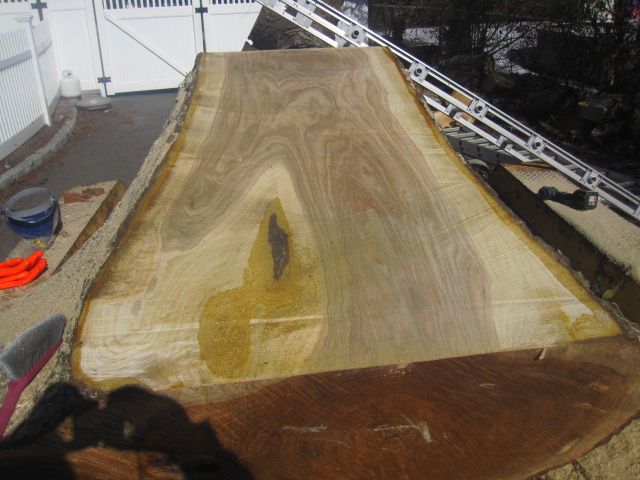
Click here for the higher quality, full size image
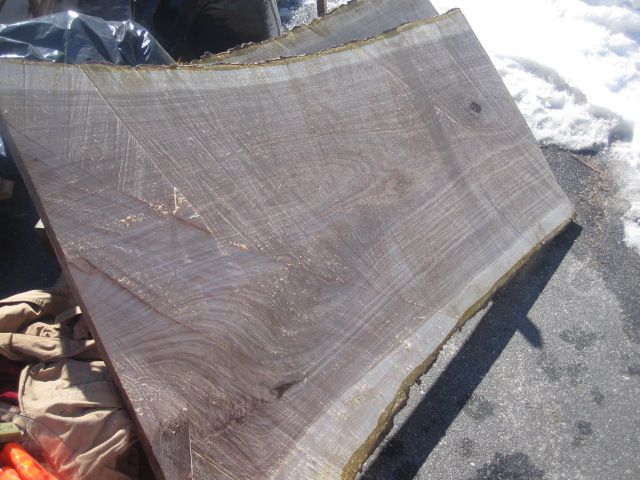
Click here for the higher quality, full size image
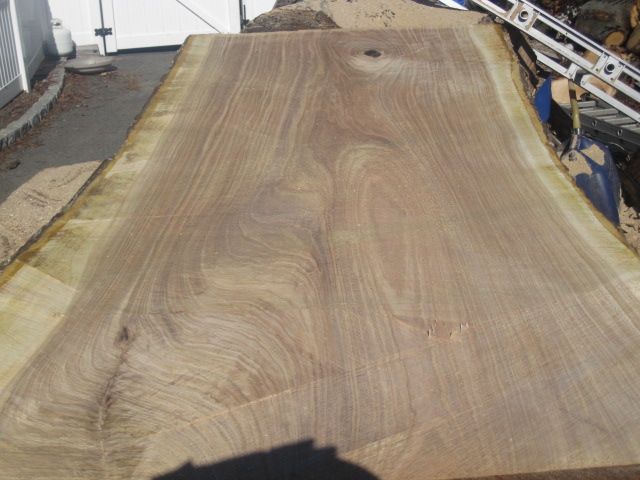
Click here for the higher quality, full size image
From contributor A:
Still looks like red elm to me. Find a limb cut to firewood length and see if you can split it with an axe.
From contributor E:
In my experience, elm has a very distinctive chevron-like pattern when viewed closely. But I have only worked with local elm, so that might not be true in all elms.
From contributor G:
I have sawn some Siberian elm that looks just like this. I do not know if Siberian elm goes by other names.
From contributor T:
The heart looks like it could be an elm or butternut. I've never milled butternut but I have various elms and I don't ever remember seeing a yellow inner bark like that. The only species that has that down here in my area is walnut. I can't see the bark but that would eliminate one or the other.
When you first milled it, did the heart have a light greenish hue to it for a little while? Were there any nuts around where the tree was?
From the original questioner:
No, there weren't any nuts around, but the leaves looked to be that of an elm. I am familiar with walnut (black walnut mostly) and am sure it's not a black walnut, at least. Most of the black walnut I mill has that greenish color in it that you mentioned. As for the butternut, I have very limited experience with it - only milled one log some time ago. But didn't know they grew this large - this log is 62'' at its widest. I greatly appreciate all the input, as I just like to be accurate for my customers. Not that I'm in a rush - this baby is gonna be drying for a while.
From contributor T:
Did the butternut you milled previously have that yellow inner bark? I think that will be the thing that helps you identify this species because not many will have that.
From contributor C:
I agree on the distinctive chevron grain pattern found in elm. Whatever it is, it's nice looking wood.
From contributor J:
I would say it is a common walnut/English walnut. I have some and it dries really well.
From contributor D:
Butternut will have a chambered pith, like walnut has. I'd say elm also. Like others have said, look for the zigzag grain pattern. I you want to send me a 3x3" sample I believe I could nail it down for you. I'm a forester during the day, woodworker after 5. ID wood samples for folks from time to time.
From the original questioner:
Thanks. As always, the WOODWEB boys are a big help. Contributor D, I think I might take you up on your offer.
From contributor R:
The chambered pith on butternut is a very good point. The only wood I have ever seen with a yellow inner bark like that is apple, but an apple the size of your log would be one in a million.
I highly doubt this is English walnut, as that looks like a chocolaty American walnut with black streaking and different bark. Assuming you chainsaw milled this, how long did each cut take? How hard is this compared to other logs you have sawn? Butternut would be fairly easy to mill, but elms should be pretty hard and possibly a little jumpy while cutting due to the interlocked grain.
I think what everybody means by "chevron grain" is miniature growth rings within annual rings. I posted something a while ago regarding this and if the mini growth rings are actually a record of the growth season's rainfall.
Can you post a picture zoomed into the grain? I've sawn red elm, and American (white) elm, but never a Siberian or other imported variety.
From contributor D:
The wavy bands folks are talking about are found in the elm and hackberry (cousin of the elms) summer-wood. They may be part of the parenchyma cells(?). The wavy bands look something like: ^^^^^^^^. Take a single edge razor blade and cut a nice end grain cut. Might need to wet the end grain after cutting and view with a 10X lens. You will see the wavy cells in elms. I can normally see them without a lens, but I've been doing this for close to 30 years. It's kinda neat. Here's a picture of the end grain of elm with the wavy pattern.
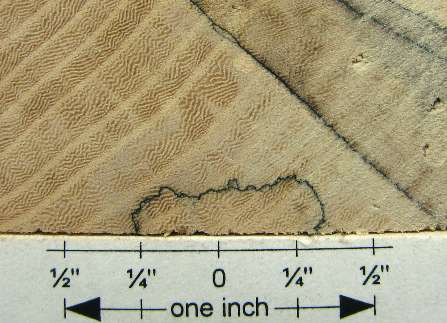
Click here for the higher quality, full size image
From contributor A:
That photo also shows spalt.
From the original questioner:
I definitely don't think it's English walnut, although I would be quite happy if it were, being that English walnut is not all that common here on Long Island. I actually have an English walnut coming to me soon and the bark, although similar, does not look the same. Cutting this went quite smooth but I did have a brand new chain. The sap of this tree is not very thick or sticky, and it is literally pouring out. I saw a picture of a beechnut tree which had a similar bark, and I would say that cutting this was similar to slabbing white oak. I'm still thinking elm, but the mystery goes on.
From contributor T:
I wish someone would explain that yellow inner bark.
From contributor N:
Looks like elm to me. Elm does not have a pleasant scent. The picture is an elm table from one of my elm slabs.
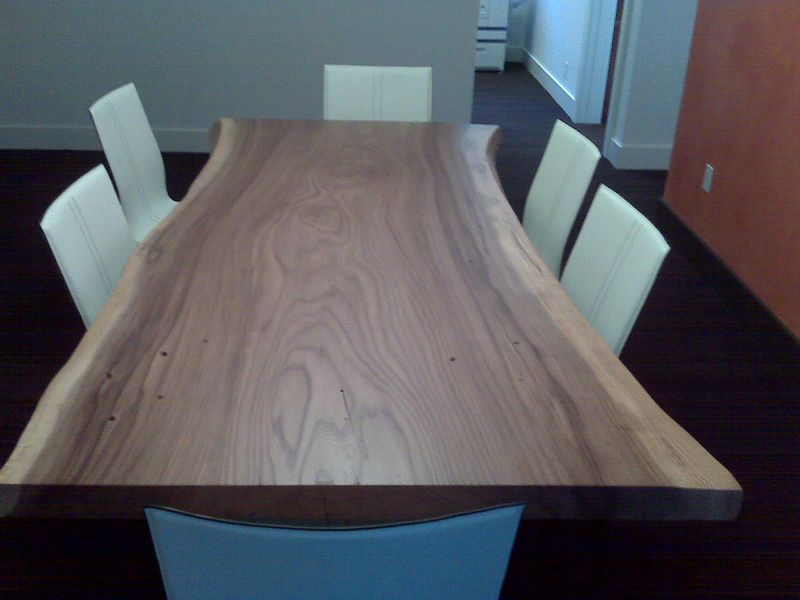
Click here for the higher quality, full size image
From contributor T:
Did your elm have a yellow inner bark like that?
From the original questioner:
I took a magnifying glass to the end grain and surprisingly did not see the wavy pattern you mentioned.
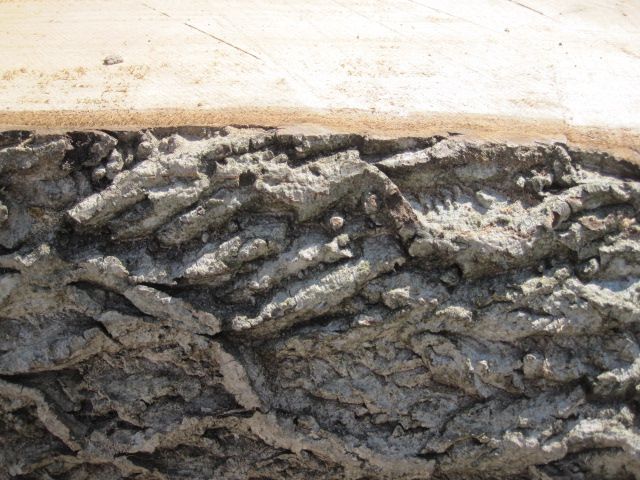
Click here for the higher quality, full size image
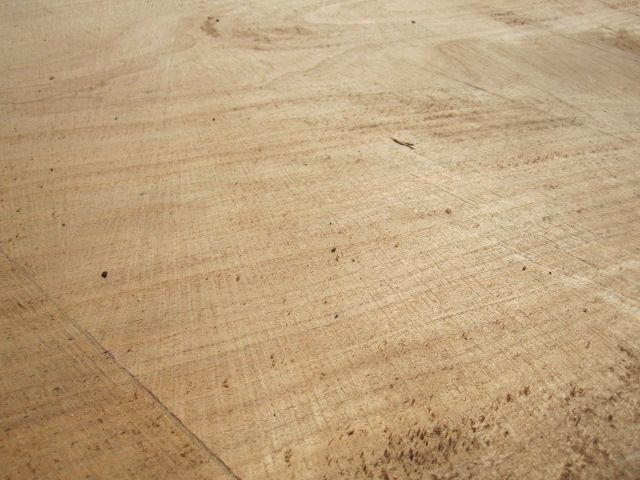
Click here for the higher quality, full size image
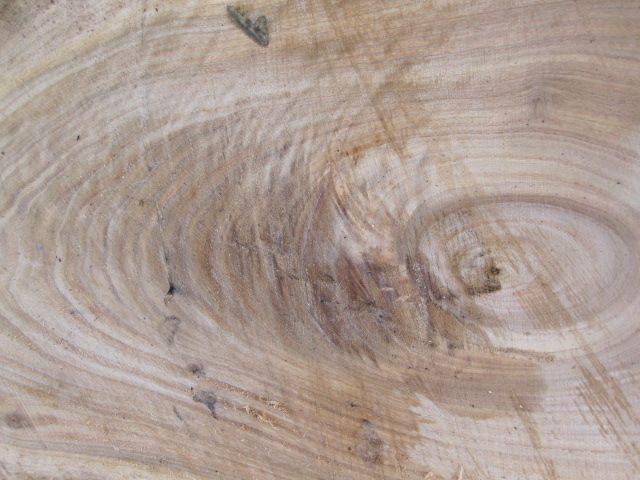
Click here for the higher quality, full size image
From contributor T:
If no one is going to address the yellow inner bark question, someone should at least have the common decency to tell me to shut up about it. :-)
From the original questioner:
I have no idea about the yellow color. The only clues I can give are: this log is approximately 62" in diameter and it is a wide included bark crotch. The tree stood approximately 90' tall with a straight trunk about 16' tall. The tree guy said it was a beechnut tree. I am very familiar with beech, but not "American beechnut." I thought elm right away, then turned to you guys.
From contributor W:
Okay, so it is not elm. That last picture would have shown the wavy bands that obviously are not there. I have to go with butternut. That explains the heartwood color and the yellow inner bark. There is my yellow inner bark theory!
From contributor D:
Send me a wood sample with knot or center of tree. Both will show a chamber pith, if there is one. I don't know a thing about yellow bark in butternut! Not saying you are wrong about yellow bark, just saying I'm not familiar with the inner bark of butternut.
From contributor T:
I'm not familiar with butternut at all, as we don't have it here. But I am sure feeling the love now. My point is that it rules out elm right away, so I did not understand why there were so many saying it was elm. If butternut has it, then it's sounding like the best candidate so far.
From contributor W:
I do not know specifically that butternut does have yellow inner bark, but as it is a kissing cousin of black walnut, and as walnut does, then...
From contributor A:
The picture of the bark is not butternut or beech. It looks like American or rock elm. The wood looks like elm. Does not look like butternut. Butternut has a bark like walnut but gray instead of brown. Find a photo of rock elm bark and compare it to the photo.
From contributor T:
Does American or rock elm have yellow inner bark?
From contributor N:
The clm I cut does have yellow hints toward the bark, just not as pronounced as in this slab. It would be great to get feedback on the smell. Elm is very distinctive.
From contributor W:
Without the wavy bands in the latewood, it is not elm. If it is not butternut, then the mystery persists.
From contributor S:
What about Kentucky coffee tree?
From contributor T:
The inner bark is the key to identifying this particular species, and helps to rule out many species that it could otherwise be. It's too pronounced to have been caused by environment or possibly some disease in an early stage, such as the hints contributor A mentions probably were. I'll eat my hat if you find any kind of elm in my region that has yellow inner bark.
I've harvested a lot of eastern red cedar and in areas where the sulfur content in the soil is high, the sapwood in the trees is yellow, whereas it is normally white. But that tree appears at least to me to have yellow inner bark as part of its DNA, if you will, so all of the trees of that species will have it. Too bad no one has compiled a list of species that have yellow inner bark. This game would be much easier if we had such a list.
What we know:
The region it was harvested.
The leaves appear similar to that of an elm.
It does not produce fruit (nuts).
It does not have chevrons.
It does not have a chambered pith.
The inner bark is yellow.
Didn't help me but maybe it'll help someone. Were you with the logger to harvest the tree or was it a drop-off? This is better than a murder mystery.
From contributor T:
Contributor S, I think you are onto something. A quick search showed that the lumber is often mistaken for red elm which would explain contributor A's guess. Also the bark looks similar and most all the references I glanced at noted the narrow sapwood. Never saw anything about yellow, but maybe just wasn't mentioned. I think you may have solved it. Closer than anyone else I believe.
From the original questioner:
I look forward to coming home to read what you guys wrote! Yes, I was with the tree guy when he cut it, and I think I'm giving you all the clues I can. I just cut a sample of the pith and mailed it to contributor D today, so hopefully we'll have a final answer in a couple days.
From contributor D:
Dang, ya'll got me in the hot seat! Me and my big mouth. As long as it's a native American tree I think I should be able to ID. I've never tried to ID foreign wood! What state was this tree cut from?
From contributor T:
Long Island. I have several hundred end grain samples as well and a 16x loupe. If you can't nail it, let me have a shot.
From the original questioner:
Yes, Long Island. I have been shocked at some of the species that I have here. Last summer I even got a piece of Osage orange... I did look up some info on the white walnut, aka butternut, and I guess it had some similar characteristics to my piece here. If we still can't figure out what this is, I found an arboretum not too far away and maybe they can help.
From contributor W:
Did you see a leaf, and if so, please describe it. Both butternut and Kentucky coffeetree have large compound leaves, while elm has a simple leaf.
From contributor T:
I think the coffee tree is related to locust. So there's that.
From contributor A:
Yes, red elm (I think it is really September elm) and rock elm have yellow just inside the bark when felled and sawed green. Most of mine are allowed to spalt. American elm is not yellow just inside the bark.
I am sure if you find a photo of rock or red elm bark you will see the "X" pattern of elm bark and that is what is shown on the photo of the bark.
From contributor W:
The X pattern of interlocking ridges is common to a number of species in addition to elm. The interlocking bark and the narrow band of sapwood also suggests black locust.
From contributor T:
I mentioned locust because of the leaves, but the bark he shows would pass for black locust too. It looks much closer to black locust than to coffee tree bark from the photos I'm seeing in an image search.
From the original questioner:
I have milled plenty of honey and black locust here as well, and I would be shocked if it were black locust. The picture may be a little deceiving, but the bark is not as deep or gnarly as black locust. My chain on my saw also lasted four slabs worth before sharpening, telling me not locust.
From contributor R:
It's definitely not black locust! I know this specie very well. I cannot rule out butternut. I see nothing against this possibility. I have seen plenty of big butternuts with identical bark, specifically on the big ones where the bark starts to change a little (as most species do after their diameter exceeds 30" or so).
I would not rule out the chevron parenchyma cells either, without seeing a clearer picture taken closer up. I might be wrong, but I think the cell pattern in red elm is less drastic than American (white) elm.
But like you said, this is on Long Island where the wealthy have lived for hundreds of years and where you can find just about every specie in the world that grows in that temperate zone as an ornamental. You might just have an unusual exotic on your hands! These should be worth a fair amount of money to the right person, easily over the $8.00 pbf range.
I have only seen Kentucky coffee tree lumber once or twice and I remember it being more ring porous, and much redder.
I would be shocked if this is not in the walnut or elm family. Black walnut is a very forgiving wood to dry, but my experiences with butternut, white elm, and red elm have proven to have lots of tension. Dry these boards stacked in boule form with true 1x1 stickers, 16" or so apart, then buy 3 or so 10,000 pound ratchet straps from a local home center and band them up, then put a couple hundred pounds on top. Tighten up the clamps every month or so. I have found this to be the best way to dry wide stock and keep it nice and flat. Surfacing wide warped stock is a nightmare!
I recently heard from another northeast specialty lumber company owner who was telling me about butternut variations, and how different the densities can be in this specie. Apparently true American butternut is very rare and most of what you find is some kind of invasive Japanese variety. First time anybody ever told me this - I'm not sure how true it is.
Can you post a clear picture of the end grain? Don't sand it because it will blur the image. If you grab a circular hand saw with a sharp blade it should make a clean and clear surface. I'm really wondering what the heck this is!
From the original questioner:
I have been amazed at the variety of species here on Long Island. I also have an English walnut and a chestnut on the way. And I am very excited about 2 logs that may be from the early 1800s that were recently dug up in an excavating project on the north shore, which turns out to be an old abandon oil field here.
From contributor R:
I have seen butternut identical to the provided bark picture. Several barks can look identical to that including big poplar, big ash, paulownia, catalpa.
Catalpa is a possibility, and would explain the yellow bark. I sawed a nice one a few years ago and I remember the yellow inner bark which I think faded to a shade of white after drying, but this would not explain why you say your leaves look like elm.
Can you provide pictures of the leaves? That should be the proof factor here and end this!
If it's elm it will have a more dramatic saw toothed edge with the points larger than in butternut, and a more oval shape compared to the slight teardrop in the butternut leaf.
My 695 page tree identification book, William Carey Grimm's "The Illustrated Book of Trees", is confusing me. I searched the net for images and found the pictures to show the elm family as being alternate pinnately compound, and the walnut family to be opposite pinnately compound, with some slight stagger to the leaves side by side, but the descriptions for both species in my book say each is alternate pinnately compound. I have no idea why the walnut family is not considered opposite according to the diagram in the beginning for Parts, Types, and Positions of Leaves. Maybe there's a typo in my book?
Whatever they are technically considered, you should be able to determine what you have by how opposite or alternate your leaves are compared to what you dig up image searching Google.
From contributor D:
Opposite branching is like your ears on the side of your head, opposite and even side to side. Around here the commercial tree species dogwood, ash and maple have opposite branching. Catalpa is also opposite, I believe, but is not a commercial species or native. It's been naturalized over the years. I think it's from Asia. Actually, dogwood is not a commercial species. Wish it was big enough to saw. Seen very few that would, but made my mouth water. Anyway, I suggest folks contact their state forestry offices and get their tree book. It's so much easier trying to ID an oak that grows locally than searching hundred of the oaks that grows in North America is listed in the tree books of North America or some such title.
From contributor T:
I have milled catalpa but not much. I do not remember it having yellow inner bark but it is a common species down here and the leaves are nothing like locust. They resemble elm in shape but do not have the sawtooth edge pattern at all - the edges are smooth.
The grain and color of the mystery log could pass for catalpa. This image is a catalpa table made for us by a customer whose catalpa I milled for him. It is similar, but many species look similar.
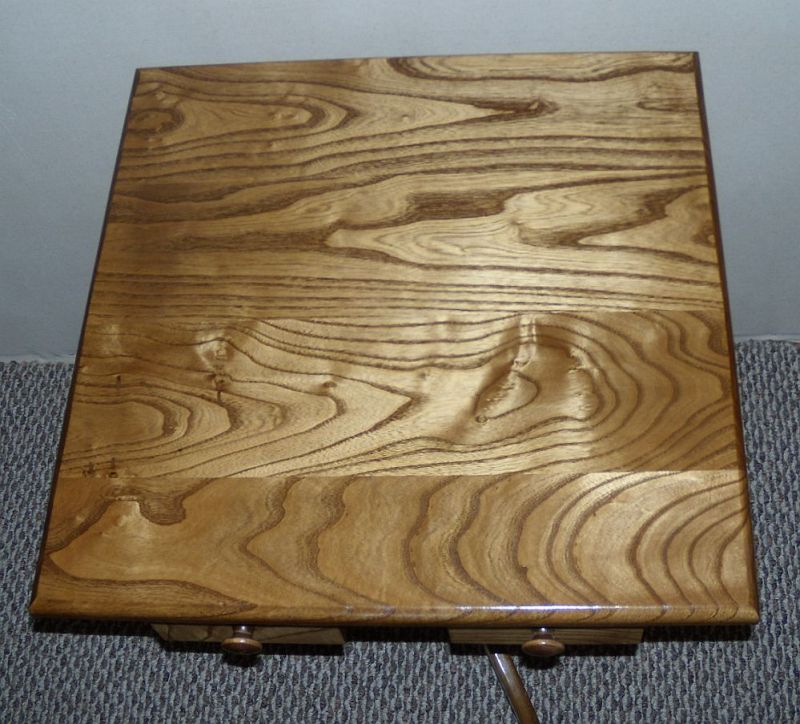
Click here for the higher quality, full size image
From contributor P:
I have sawed quite a few of both elm species (American and red), both dead and alive. Green elm stinks and my dad used to call it piss elm. Butternut comes off of the saw quite fuzzy and is very soft, easily grooved with the edge of the fingernail. Neither elm or walnut is this soft. Lack of wavy parenchyma rules out elm.
Big butternut and walnut bark is very like that in the picture. I am confused however by the color differences in the pictures of the wood. The first looks like butternut, the other two like black walnut.
No nuts on the ground may mean either lack of a mast crop, it is not a nut bearing species, or the landowner cleaned the site really well.
From contributor W:
Actually, the elm family has simple leaves that are alternately spaced on the twig (one leaf per petiole). The walnut family, including the hickories, have compound leaves with a long petiole on which are arranged a number of leaflets. These compound leaves are also spaced alternately on the twig. A leaf would clear this up quickly, but what fun would that be?
From contributor A:
If it was a catalpa there would have been beans and heart shaped leaves lying around. Butternut is more yellow than that wood. You guys are a hard lot to sell to. Still sticking to elm.
From contributor T:
Maybe it's elm, but what species of elm have you cut that had that color inner bark? Someone on another forum mentioned that it could be a hybrid, since Long Island is known to have more than their fair share of that. Not my idea - just tossing it out there.
From contributor A:
The wide sapwood is why you are seeing yellow. That is the cambium layer and that may have been a fast growing tree. Yard trees that get watered with the lawn and fed grow faster than other trees. I once took a walnut tree down that grew just downhill of some turkey barns. Two men could not reach around that tree. When I cut it down the sapwood was almost 4 inches thick and the tree was only 35 years old. There was 3/4 of an inch between the growth rings. I can tell when a white oak log comes from a north facing slope around here. The trees grow differently in different places. Still looks like elm to me.
From contributor T:
I believe the cambium layer is considerably thinner than the inner bark (phloem). I don't think that yellow band in the picture is the cambium - it's much too wide to be unless I'm not remembering things right.
From contributor D:
Got the wood sample today.
Easy to dent with fingernail
Has tyloses
Chamber pith
Butternut!
Reason for yellow inner bark in Long Island: male dogs!
Some folks got this correct - give yourself a pat on the back. I was leaning towards red elm, aka slippery elm. The pictures were not that clear. Anyway, butternut it is.
From contributor T:
It's good to know the mystery is solved.
I emailed Brian at Artisan Lumber in Lunenburg Mass, because on his website, where he said that butternut was their favorite N.A. hardwood. I emailed him the pictures and told him of this thread. I got a call from him a few hours ago and this is what he said.
According to him, it is a butternut/Japanese walnut hybrid. He claims there are very few if any true butternut left. When I told him it grew on Long island he shot back "well there's no chance it is a true butternut then."
He also said that he thought the more Juglans ailantifolia there was compared to juglans cinerea, the yellow inner bark would be wider like the one in the picture.
So, for what that's worth, there's one possible piece to the puzzle. I did try to convince him that yellow bark was due to the tree being the community canine pee tree, but he wasn't buying any of that. ;)
From contributor P:
Butternut is indeed getting scarce. I have about 6 left in my woods and am watching them like a hawk for any sign of distress. In my career as a consulting forester I used to see quite a few in the early 80's, but not now.
From contributor D:
Not sure I have seen a butternut tree in person - they don't grow here. Just plain ol' butternut is as far as I can take the answer. If you want to call it a variety "whatever" that will be up to someone else.
From contributor R:
I have sawn a few dogwood shorts for guys doing custom hand planes, but it warps and splits badly. Out this way the state foresters do not even know all the species that have grown into the wild. I do not believe NY or NJ has such a book available. Catalpa leaves are easy to tell because they are very big in a heart shape, I think similar to Paulownia.
Contributor T, if you told me that table top was red elm I would believe you. It's very close in grain and color.
From the original questioner:
The mystery is solved! I also thought it was elm. Thank you for taking the time to clear this up.
From contributor D:
You are very welcome. My guess is, since you thought a butternut leaf looks like an elm, you had a leaflet from the butternut tree. Butternut has compound leaves, multi leaflet/leaf. An elm is a simple leaf.











